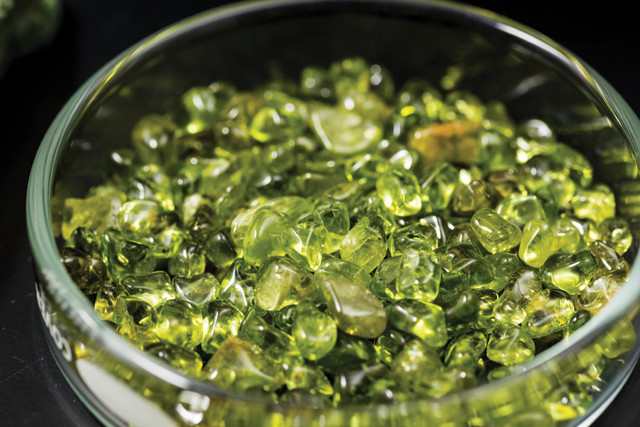
by Mary Caperton Morton Thursday, December 14, 2017

Olivine is the dominant mineral in Earth's lithosphere, and thus largely controls the strength of tectonic plates. Credit: Evan Krape/University of Delaware.
Plate tectonics involves some of the most powerful forces on Earth, but the lithosphere, of which the plates are made, is not infinitely strong: Weaknesses in the lithosphere allow it to break apart and form plate boundaries. Determining the strength of tectonic plates based on field observations has proved tricky, however, due to the sheer scale of plates, while experiments and calculations in the lab on olivine — the main mineral that makes up the lithosphere — have depicted plates as misleadingly strong. In a new lab-based study, researchers have taken a novel approach to testing olivine’s strength, and the results fit existing models of plate tectonics better than previous efforts.
“The strength of the lithosphere plays a massive role in our understanding of plate tectonics,” says Kathryn Kumamoto, a geologist at Stanford University and lead author of the new study, published in Science Advances. “Plates have to be rigid enough that they don’t deform much in the middle, or else we’d see faults and earthquakes everywhere instead of mostly focused along plate boundaries. But they also have to be weak enough that they can form new boundaries, or we wouldn’t have plates at all.”
Experiments on olivine in previously published studies have shown mixed results, suggesting estimates of the mineral’s strength that vary by as much as a factor of three. “If you plot all the data points from all the experiments, it would look like a shotgun blast: scattered all over the place,” says David Kohlstedt, a rheologist at the University of Minnesota in Minneapolis who was not involved in the new study. Extrapolating these scattered findings up to the scale of tectonic plates often leads to predictions of plate strength that are much higher than observations suggest. For example, field measurements of lithospheric flexure — that is, how much the lithosphere bends under a given weight (or rebounds when a weight is removed) — suggest that the maximum stress that can be supported by the lithosphere before it breaks is about 200 megapascals, but laboratory olivine experiments tend to predict maximum stresses closer to 1 gigapascal — a fivefold difference. “These discrepancies have caused a lot of problems because we’ve been unable to use experimental predictions to understand the strength of tectonic plates,” Kumamoto says.
In the new study, Kumamoto and her colleagues turned to a technique commonly used in materials science called nano-indentation, which tests the hardness of a small volume of a material. “This technique is a newcomer to the geosciences, but it’s quick and easy to perform, so we were able to gather a lot of data very efficiently,” Kumamoto says. In nano-indentation, a tiny, fine-tipped instrument is pressed into a material — in this case an olivine crystal — at a known force, and the size of the indent created by the instrument, which corresponds to the strength of the crystal, is measured.
Kumamoto’s team used naturally formed single olivine crystals of different sizes for their experiments. Previously, most experiments were performed using various hardness and strain tests on aggregate olivine crystals made by pressing many uniform individual olivine grains together to form a rock. “The advantage of a multigrain rock is that you can get a sense of average crystal behavior, but with a single crystal, you can learn a lot about the details of deformation,” she says.
The team found that the size of the crystal they studied directly corresponded to its strength, with smaller crystals being stronger than larger crystals, a relationship known as the size effect. “This makes a lot of sense, because we see that rocks with smaller grain sizes tend to be harder, and as the grain size gets bigger, the rock gets weaker,” Kohlstedt says. The result also “helps explain why, from one lab to the next and one experiment to the next, there were such wide variations” in estimated strengths, he says. “The size of crystals you use for your experiments matters a lot.”
In previous experiments, the aggregate olivines studied were made of small grains about 10 microns wide or less, “whereas olivine crystals in the lithosphere typically are two to three orders of magnitude larger,” Kumamoto says. This explains why earlier results have been skewed, giving the impression that plates are stronger than they actually appear to be. With the impact of the size effect in hand, the team scaled up their nano-indentation results, finding that plates should tolerate stresses on the order of hundreds of megapascals, rather than gigapascals. “Incorporating the size effect into our understanding brings our experiments into pretty close alignment with field observations and models.”
Kumamoto says the next steps in the team’s research will be to conduct experiments at temperatures closer to the conditions found in the lithosphere, and to incorporate the findings into models. “So far, all of our experiments have been run at room temperature, but the interior of the Earth is a lot hotter,” she says.
© 2008-2021. All rights reserved. Any copying, redistribution or retransmission of any of the contents of this service without the expressed written permission of the American Geosciences Institute is expressly prohibited. Click here for all copyright requests.